Relationship between Visibility, Air Pollution Index and Annual Mortality Rate in Association with the Occurrence of Rainfall—A Probabilistic Approach
Abstract
1. Introduction
2. Research Object and Employed Device
3. Methodology of Data Analysis and Model Creation
4. API and PSI Calculations
- Low (1–3): low risk for increased mortality: 1.5–6.0%,
- Medium (4–6): medium risk for increased mortality: 6.1–10.6%,
- High (7–9): high risk for increased mortality: 10.7–15.3%,
- Very high (10): very high risk for increased mortality: above 15.3%.
5. AQI and API Calculations
6. Logistic Regression
7. Identification of Marginal Distributions
8. Simulation of Air Quality Indices and Weather Conditions Using the Monte Carlo Method
9. API Relationship Considering the Visibility and Rainfall Data
- -
- Simulation (10,000 samples) of air quality indices and weather conditions for Pk wet days (for a single month) using the Iman Conover method from theoretical distributions in the winter, transition and summer period.
- -
- Simulation (10,000 samples) of air quality indices and weather conditions for (30-Pk) dry days (for a single month) using the Iman Conover method from theoretical distributions in the winter, transition and summer period.
- -
- Calculation of probabilities of exceeding the Visi visibility values in separated classes (Equation (5)) for wet days in the winter, transition and summer period.
- -
- Calculation of probabilities of exceeding Visi visibility values in separated classes (Equation (5)) for dry days in the winter, transition and summer period.
- -
- Estimation of the number of days (for 10,000 samples) with visibility values in the appropriate range of variability (Equation (5)) for wet days in the winter (15 days), transition (16 days) and summer (18 days) period in a single month.
- -
- Estimation of the number of days (for 10,000 samples) with a visibility value within the appropriate range of variability (Equation (5)) for dry days during the winter (15 days), transition (14 days) and summer (12 days) period in a single month.
- -
- API calculations (for 10,000 samples) for wet days with a visibility value in the relevant range of variability (Equation (3)) in the winter, transition and summer period; for the analyzed range of variability Vis, calculations of API values are performed when the data obtained from simulations with the I-C method meet one of the conditions given in Equation (3).
- -
- Calculation of API (for 10,000 samples) for dry days with visibility value in the relevant range of variability in the winter, transition and summer period.
- -
- Determination of empirical distributions (CDF) describing the probability of exceeding the number of days with visibility in separated classes (Equation (5)) for wet and dry weather for the winter, transitional and summer period.
- -
- Determination of empirical distributions (CDF) describing the probability of exceeding API of days for visibility values in separated classes (Equation (5)) for wet and dry weather for the winter, transitional and summer period.
10. Results
10.1. Separation of Typical Periods in the Annual Cycle
10.2. Separation of Typical Periods in the Annual Cycle
10.3. Determination of Empirical and Theoretical Models
10.4. Calculation of the Number of Days with Visibility in the Assumed Period for Wet and Dry Days
10.5. Influence of Visibility on the Air Pollution Index (API) over an Annual Cycle including Rainfall
10.6. Influence of Visibility on the Air Pollution Index (API) over an Annual Cycle including Rainfall
10.7. Effect of Visibility on Mortality Risk in an Annual Cycle
11. Conclusions
Author Contributions
Funding
Institutional Review Board Statement
Informed Consent Statement
Data Availability Statement
Conflicts of Interest
Appendix A
| Variables | Coefficients | ||||||
|---|---|---|---|---|---|---|---|
| Vis = 8 | Vis = 12 | Vis = 16 | Vis = 20 | Vis = 24 | Vis = 28 | Vis = 32 | |
| PM10 | −0.121 | −0.124 | −0.127 | −0.116 | −0.086 | −0.086 | −0.096 |
| SO2 | 0.000 | 0.000 | 0.000 | 0.061 | 0.000 | 0.000 | 0.029 |
| CO | 0.000 | 0.000 | 0.000 | 0.000 | 0.002 | 0.002 | 0.002 |
| NO2 | 0.000 | −0.014 | −0.016 | −0.014 | 0.000 | 0.000 | −0.033 |
| O3 | −0.008 | −0.014 | −0.016 | −0.021 | 0.000 | 0.000 | 0.008 |
| T | 0.109 | 0.119 | 0.109 | 0.106 | 0.086 | 0.086 | 0.128 |
| w | 0.082 | 0.000 | 0.000 | 0.109 | 0.216 | 0.216 | 0.000 |
| Rh | −0.191 | −0.204 | −0.195 | −0.177 | −0.239 | −0.239 | −0.226 |
| Pt | −0.049 | −0.069 | −0.073 | −0.168 | −0.004 | −0.004 | −0.030 |
| Pe(z) | 0.239 | 0.585 | 0.459 | 0.000 | 1.349 | 1.349 | 0.000 |
| Pe(l) | 0.417 | 0.299 | 0.134 | 0.000 | −0.423 | −0.423 | 0.000 |
| Intercept | 17.984 | 18.716 | 17.543 | 14.311 | 23.997 | 23.997 | 22.145 |
| DP | 0.000 | 0.000 | −0.324 | −0.351 | −0.086 | ||
| Variable xi | Distribution | Parameters | p (K-S) |
|---|---|---|---|
| (I) period: Nov.–Feb. | |||
| PM10 | lognorm | μ = 3.503 σ = 0.611 | 0.489 |
| SO2 | lognorm | μ = 2.326 σ = 0.541 | 0.612 |
| CO | lognorm | μ = 6.315 σ = 0.403 | 0.745 |
| NO2 | gamma | μ = 25.744 k = 5.004 β = 4.922 | 0.225 |
| O3 | Weibull | μ = 0.211 β = 1.854 γ = 32.231 | 0.115 |
| T | Weibull | μ = −77.42 β = 17.42 γ = 80.149 | 0.625 |
| Rh | GEV | k = −0.014 β = 1.159 μ = 1.749 | 0.415 |
| (II) period: Mar.–Apr. and Sep.–Oct. | |||
| PM10 | Lognorm | μ = 3.462 σ = 0.492 | 0.951 |
| SO2 | Lognorm | μ = 1.963 σ = 0.527 | 0.924 |
| CO | Lognorm | μ = 6.112 σ = 0.398 | 0.625 |
| NO2 | Lognorm | μ = 3.007 σ = 0.441 | 0.215 |
| O3 | GEV | k = 0.237 β = 20.164 μ = 40.020 | 0.416 |
| T | Weibull | β = 5.921 γ = 31.941 μ = 20.478 | 0.321 |
| Rh | Weibull | k = 12.053 β = 150.112 μ = −72.321 | 0.474 |
| (III) period: May–Aug. | |||
| PM10 | lognorm | μ = 3.207 σ = 0.343 | 0.865 |
| SO2 | GEV | k = −0.072 β = 1.666 μ = 4.307 | 0.406 |
| CO | GEV | k = 0.06 β = 80.513 μ = 282.12 | 0.381 |
| NO2 | lognorm | μ = 2.902 σ = 0.402 | 0.911 |
| O3 | GEV | k = 0.177 β = 14.372 μ = 54.021 | 0.633 |
| T | Weibull | β = 2.145 γ = 2.224 μ = 0.318 | 0.972 |
| Rh | normal | μ = 66.52 σ = 0.102 | 0.846 |
| P | lognorm | μ = 4.006 σ = 0.734 | 0.242 |
| Visibility | Spring Period | Summer Period | Winter Period | |||
|---|---|---|---|---|---|---|
| Wet | Dry | Wet | Dry | Wet | Dry | |
| Vis < 8 | 0.2046 | 0.4597 | 0.3203 | 0.2427 | 0.5269 | 0.4270 |
| Vis = 8–12 | 0.2089 | 0.3771 | 0.5233 | 0.3361 | 0.2393 | 0.2708 |
| Vis = 12–16 | 0.2989 | 0.4951 | 0.4639 | 0.5245 | 0.4363 | 0.6095 |
| Vis = 16–20 | 0.1512 | 0.3101 | 0.3307 | 0.6060 | 0.3382 | 0.4557 |
| Vis = 20–24 | 0.3525 | 0.5228 | 0.0933 | 0.6296 | 0.4995 | 0.1078 |
| Vis = 24–28 | 0.5082 | 0.1041 | 0.2030 | 0.2690 | 0.5768 | 0.4916 |
| Vis = 28–32 | 0.6401 | 0.0846 | 0.4932 | 0.2388 | 0.4179 | 0.2758 |
| Vis > 32 | 0.3776 | 0.4473 | 0.0991 | 0.5276 | 0.5013 | 0.1222 |
| Visibility | Spring Period | Summer Period | Winter Period | |||
|---|---|---|---|---|---|---|
| Wet | Dry | Wet | Wet | Dry | Dry | |
| Vis < 8 | 0.2216 | 0.2282 | 0.2033 | 0.2318 | 0.2336 | 0.2213 |
| Vis = 8–12 | 0.2116 | 0.2350 | 0.2379 | 0.2134 | 0.2086 | 0.2015 |
| Vis = 12–16 | 0.2262 | 0.2173 | 0.2051 | 0.2228 | 0.2147 | 0.2281 |
| Vis = 16–20 | 0.2090 | 0.2129 | 0.2364 | 0.2258 | 0.2277 | 0.2394 |
| Vis = 20–24 | 0.2348 | 0.2111 | 0.2145 | 0.2071 | 0.2180 | 0.2364 |
| Vis = 24–28 | 0.2225 | 0.2040 | 0.2230 | 0.2354 | 0.2005 | 0.2216 |
| Vis = 28–32 | 0.2003 | 0.2189 | 0.2228 | 0.2084 | 0.2223 | 0.2198 |
| Vis > 32 | 0.2299 | 0.2059 | 0.2392 | 0.2214 | 0.2081 | 0.2371 |



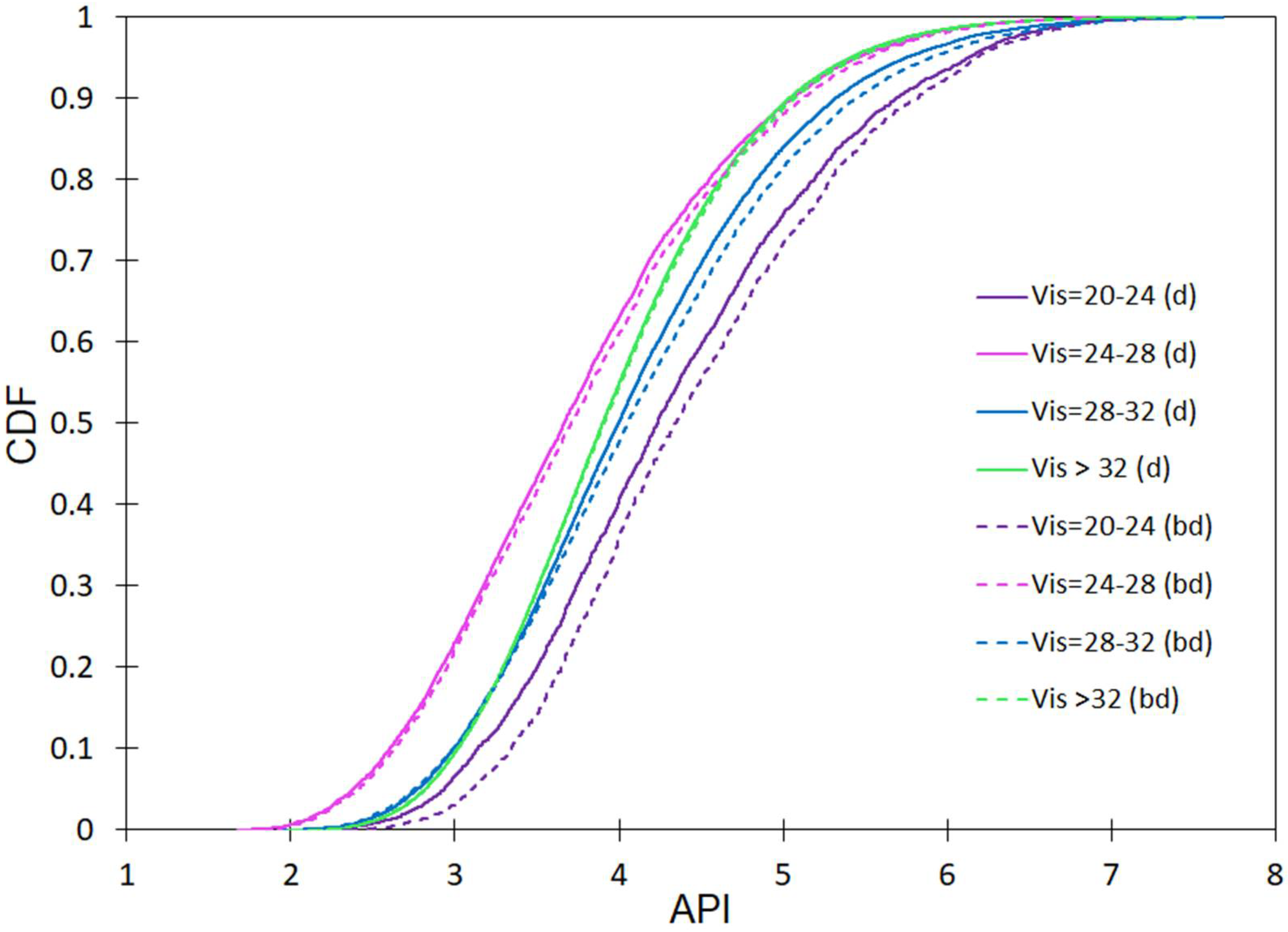

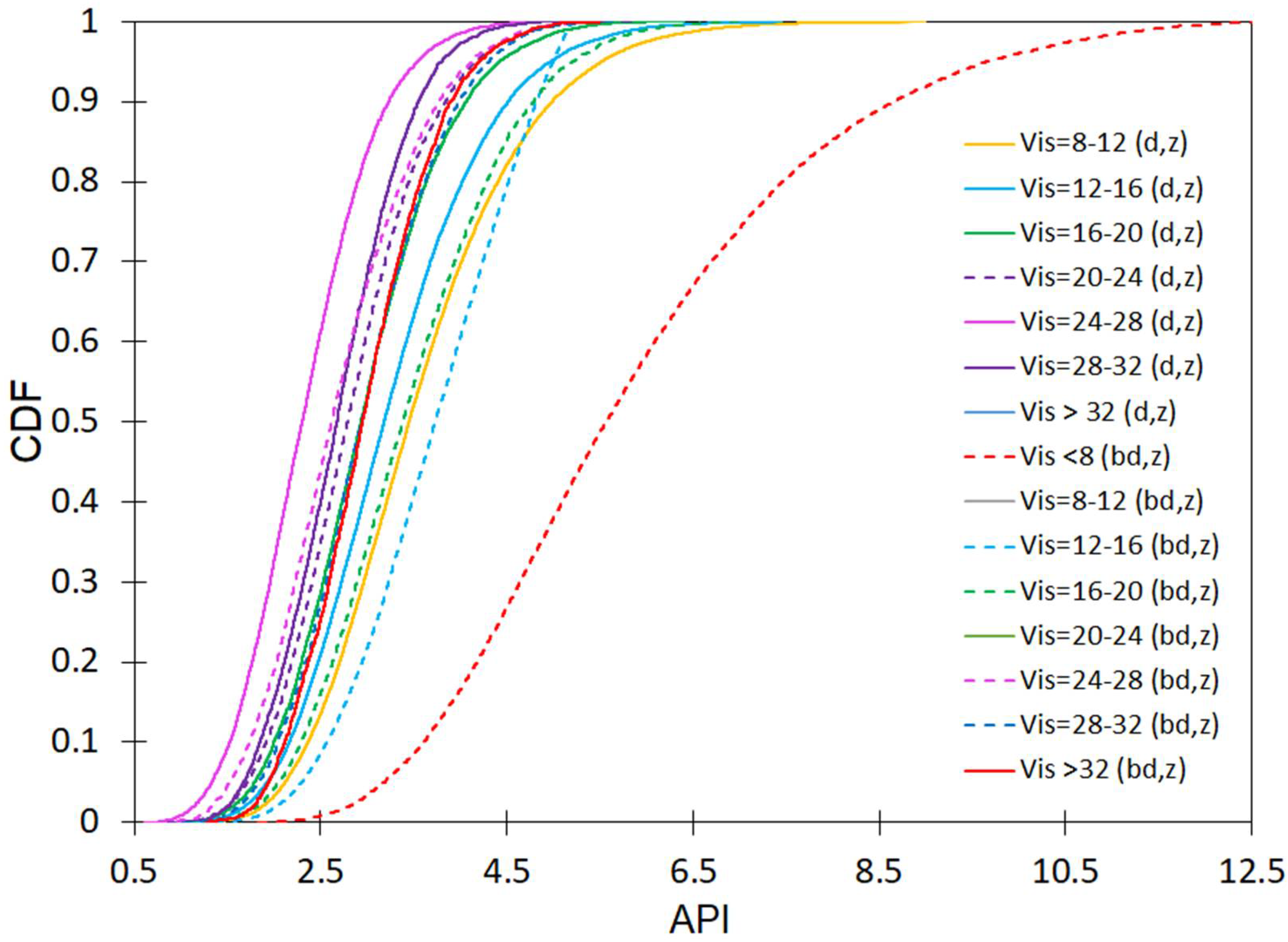
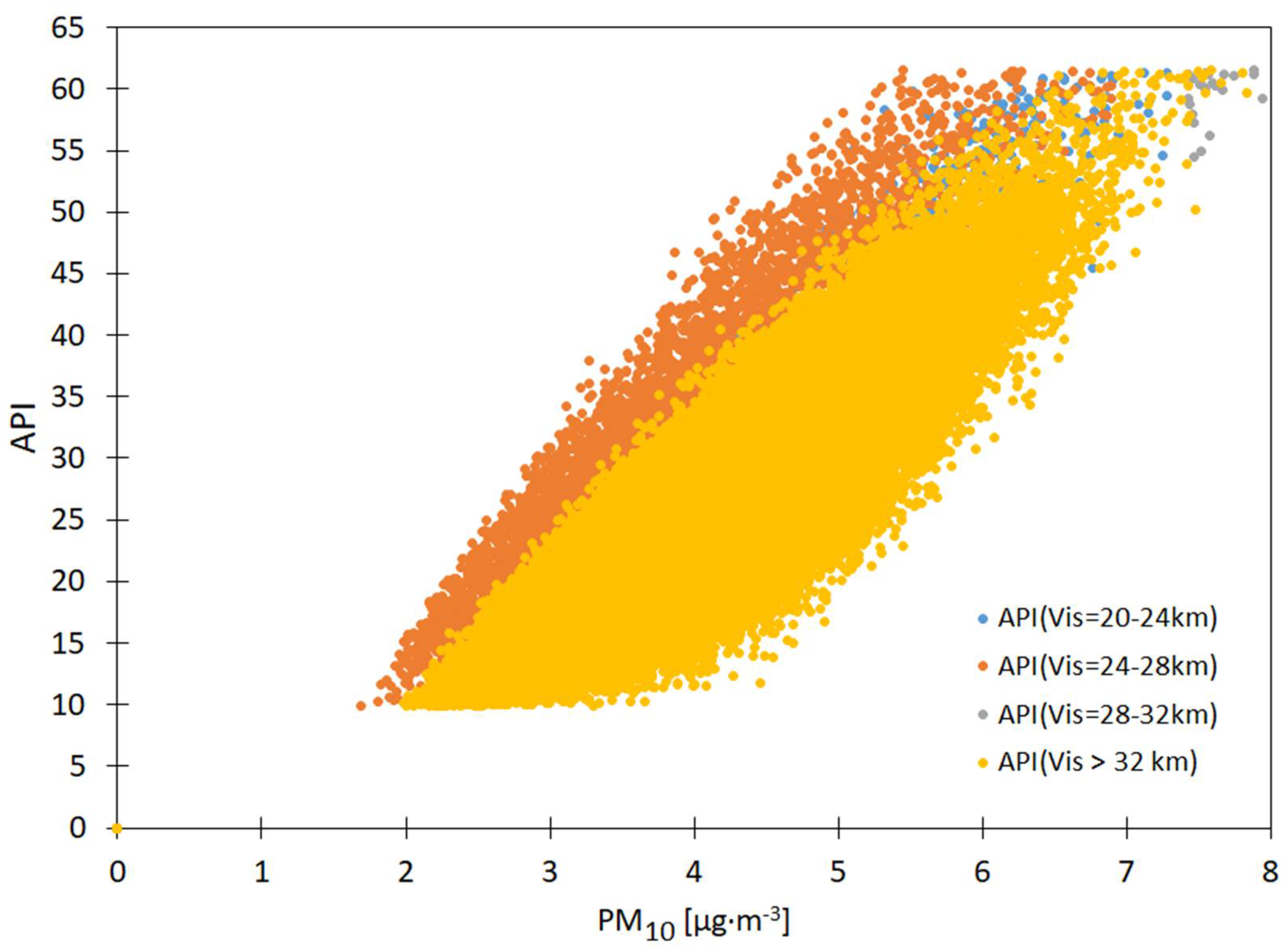


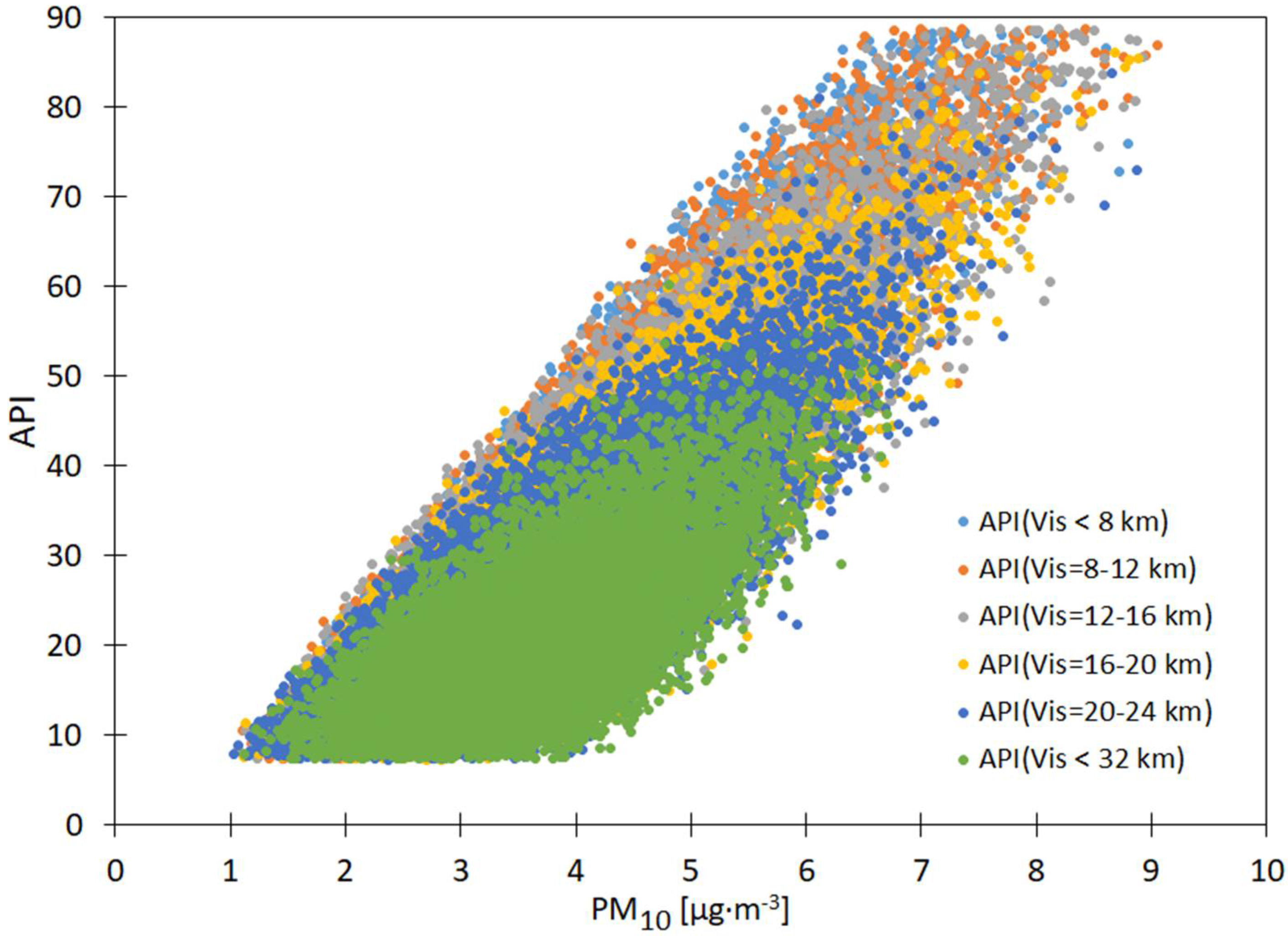



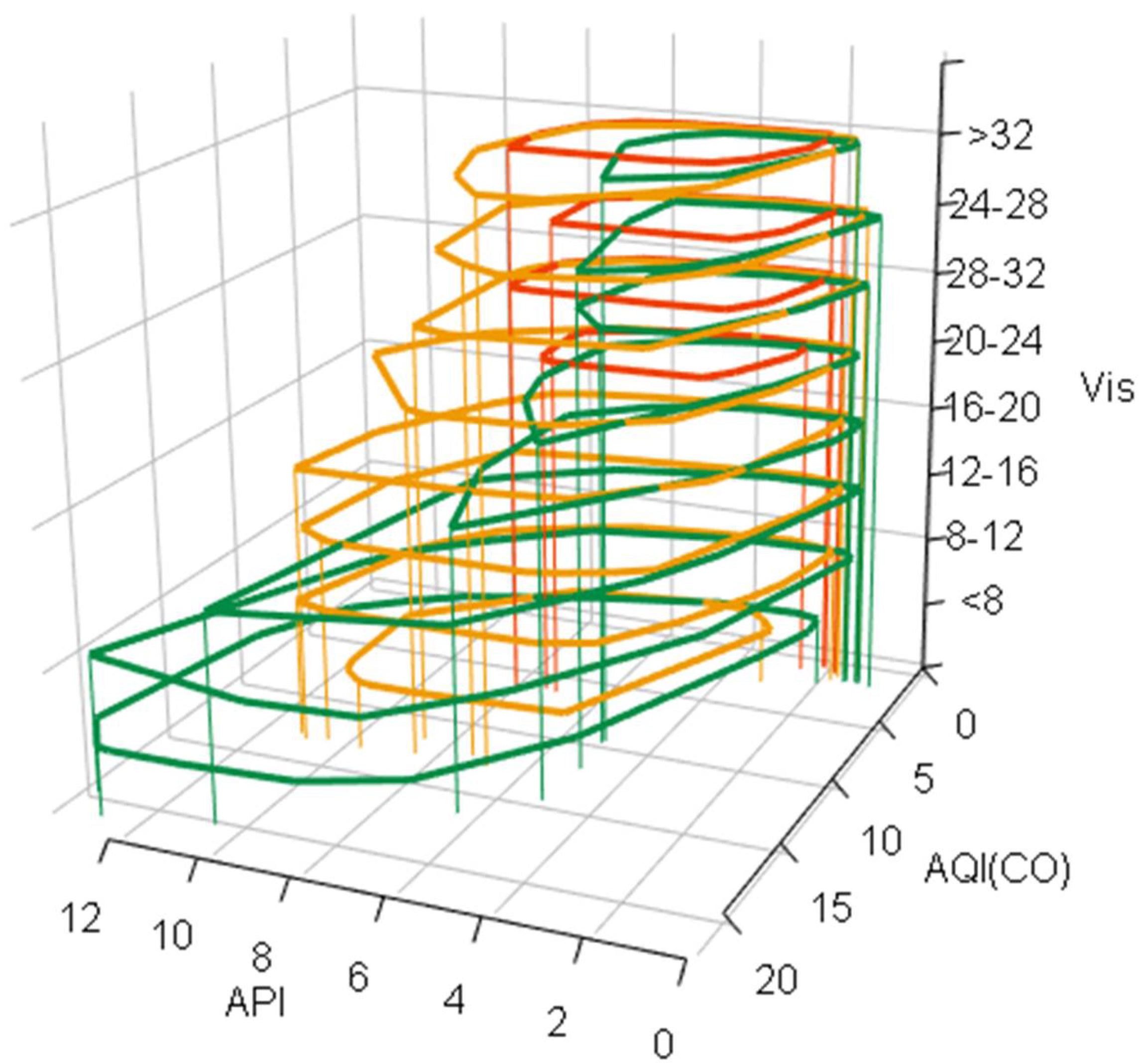




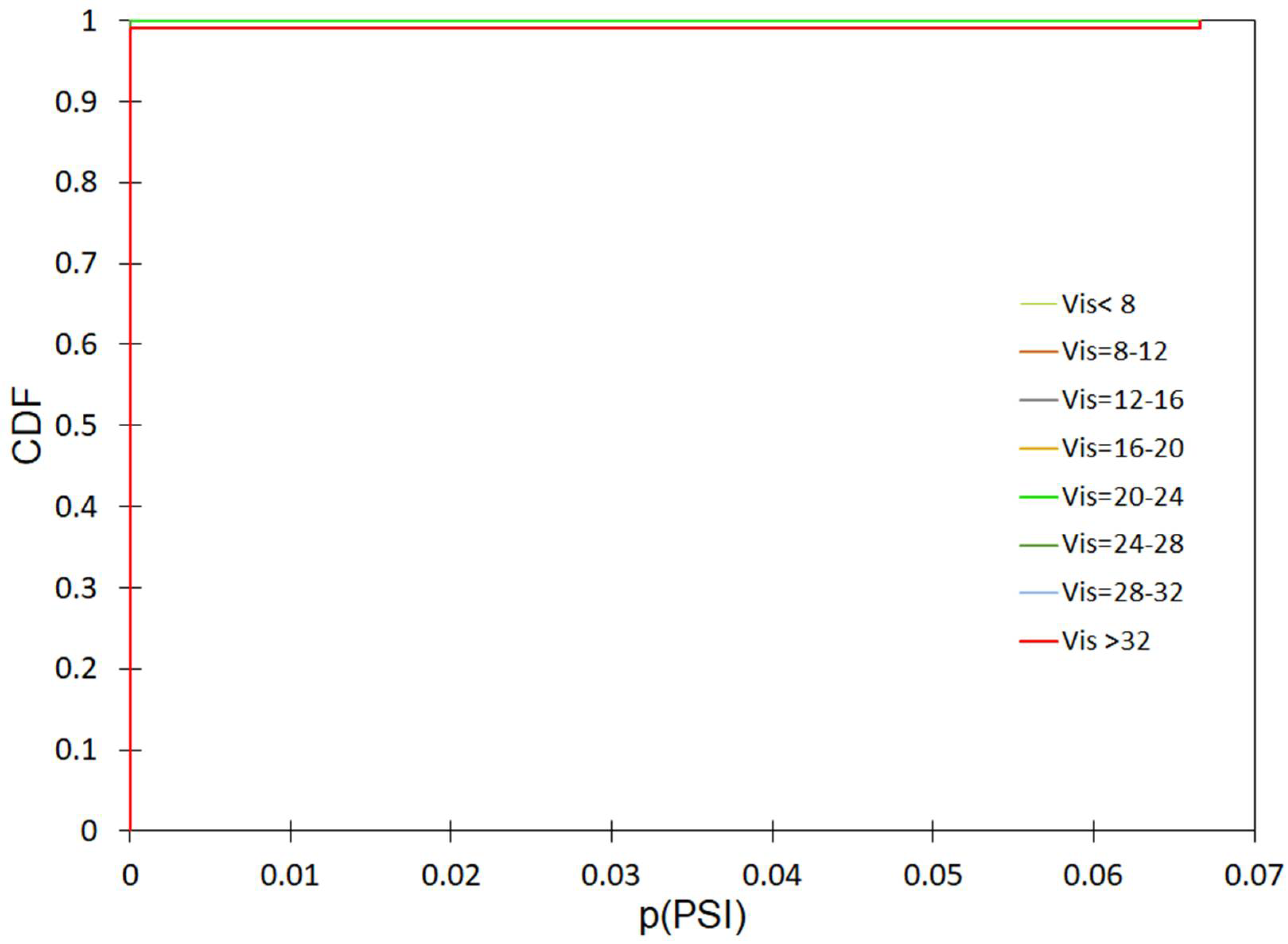


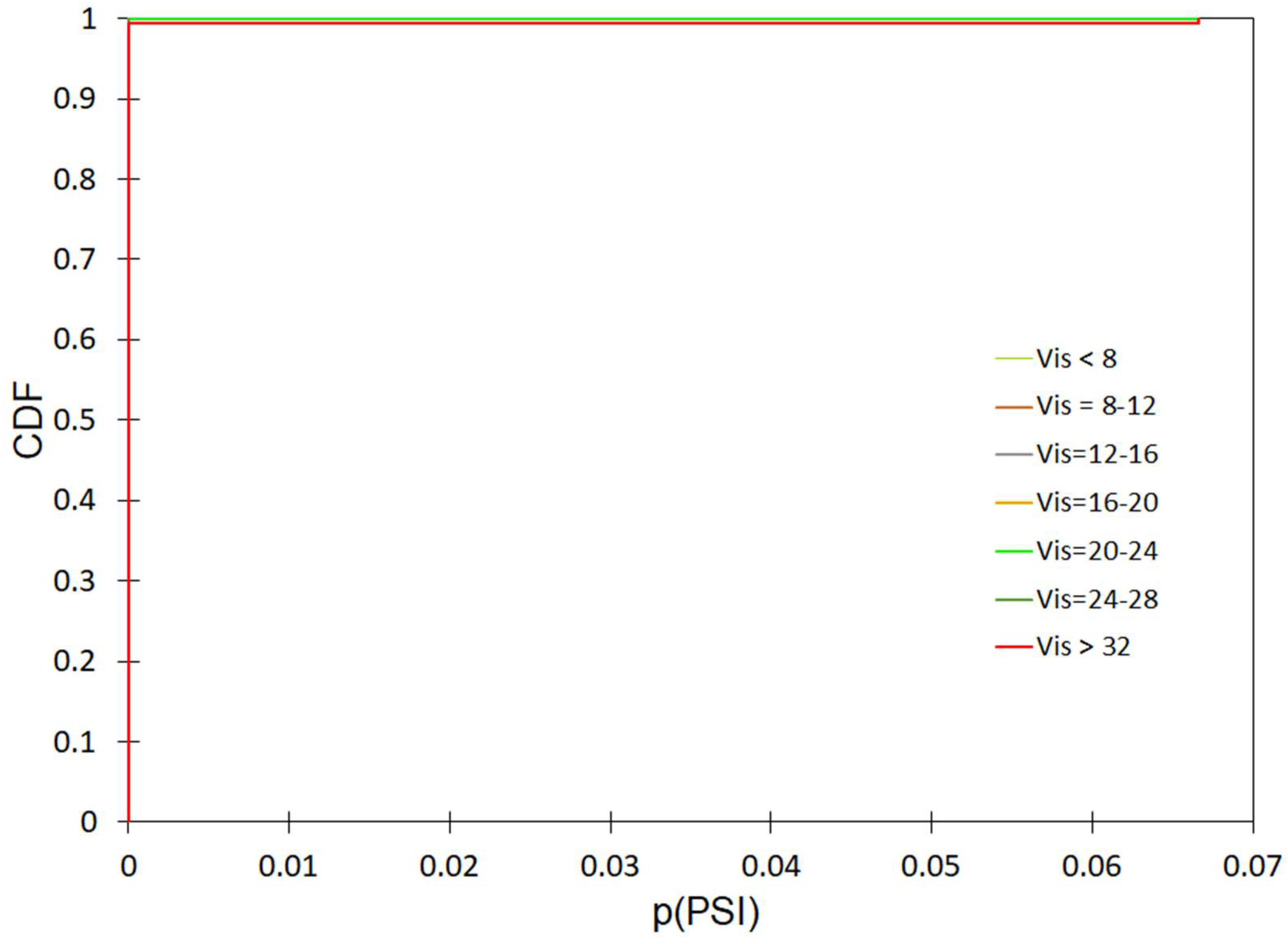
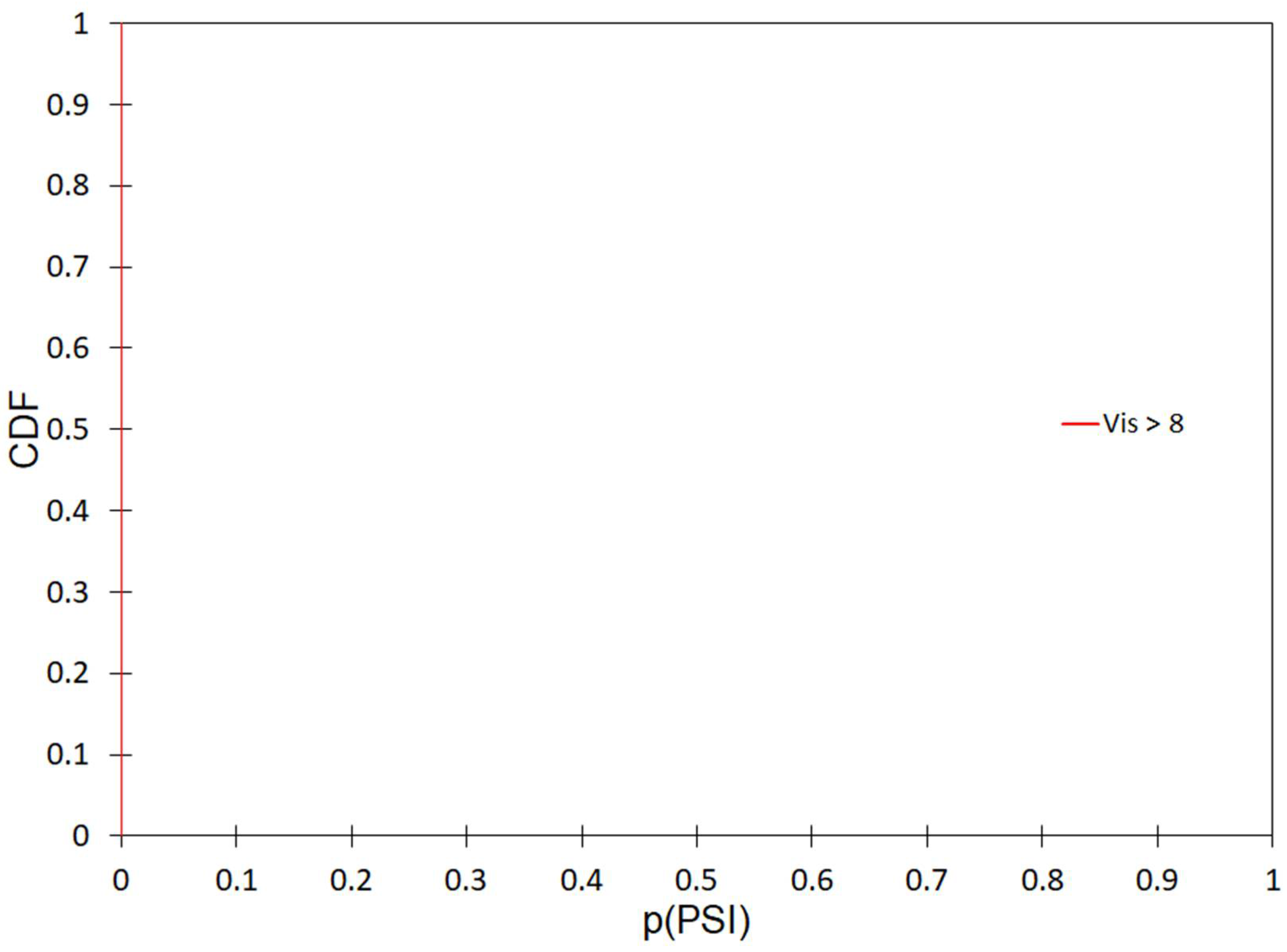
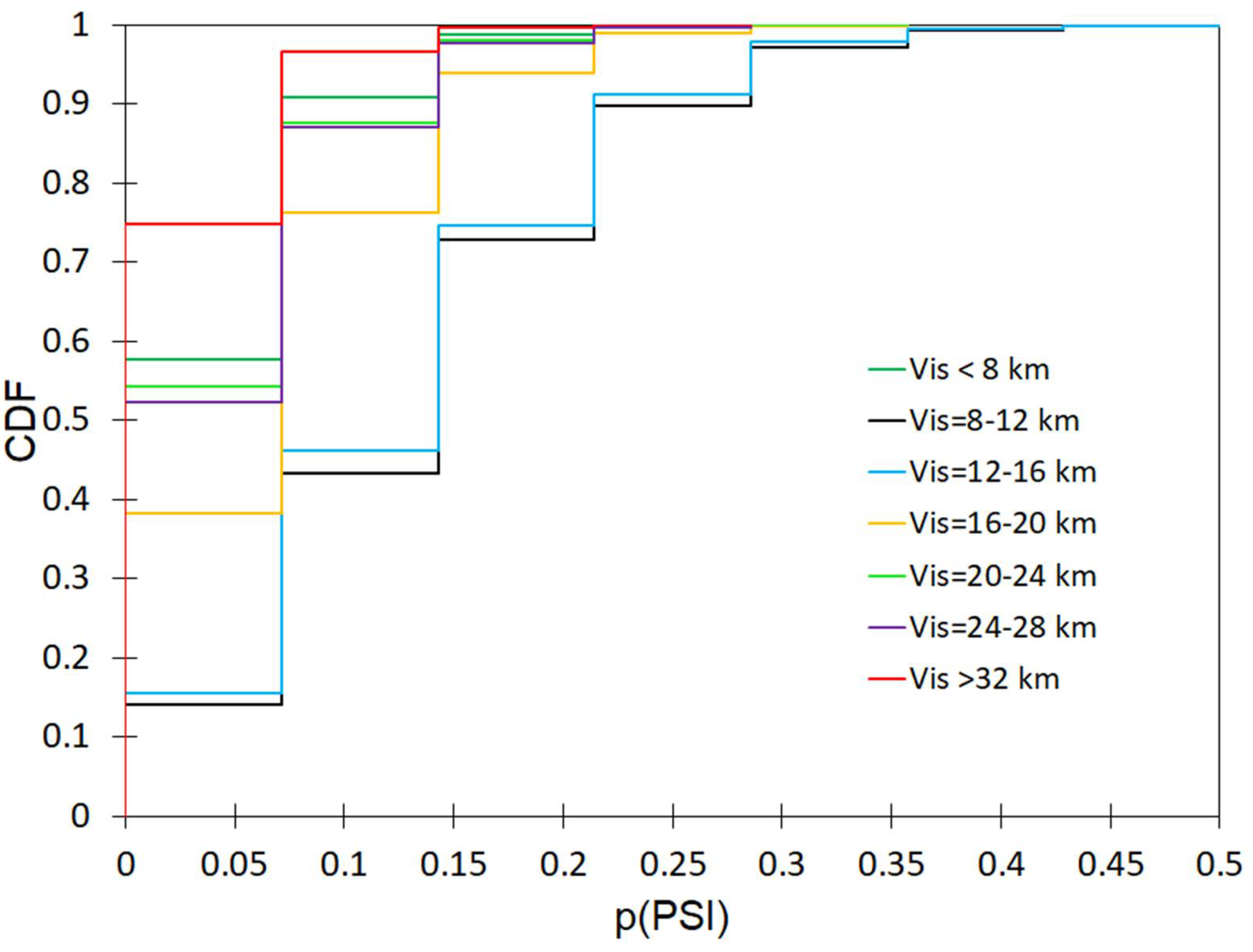
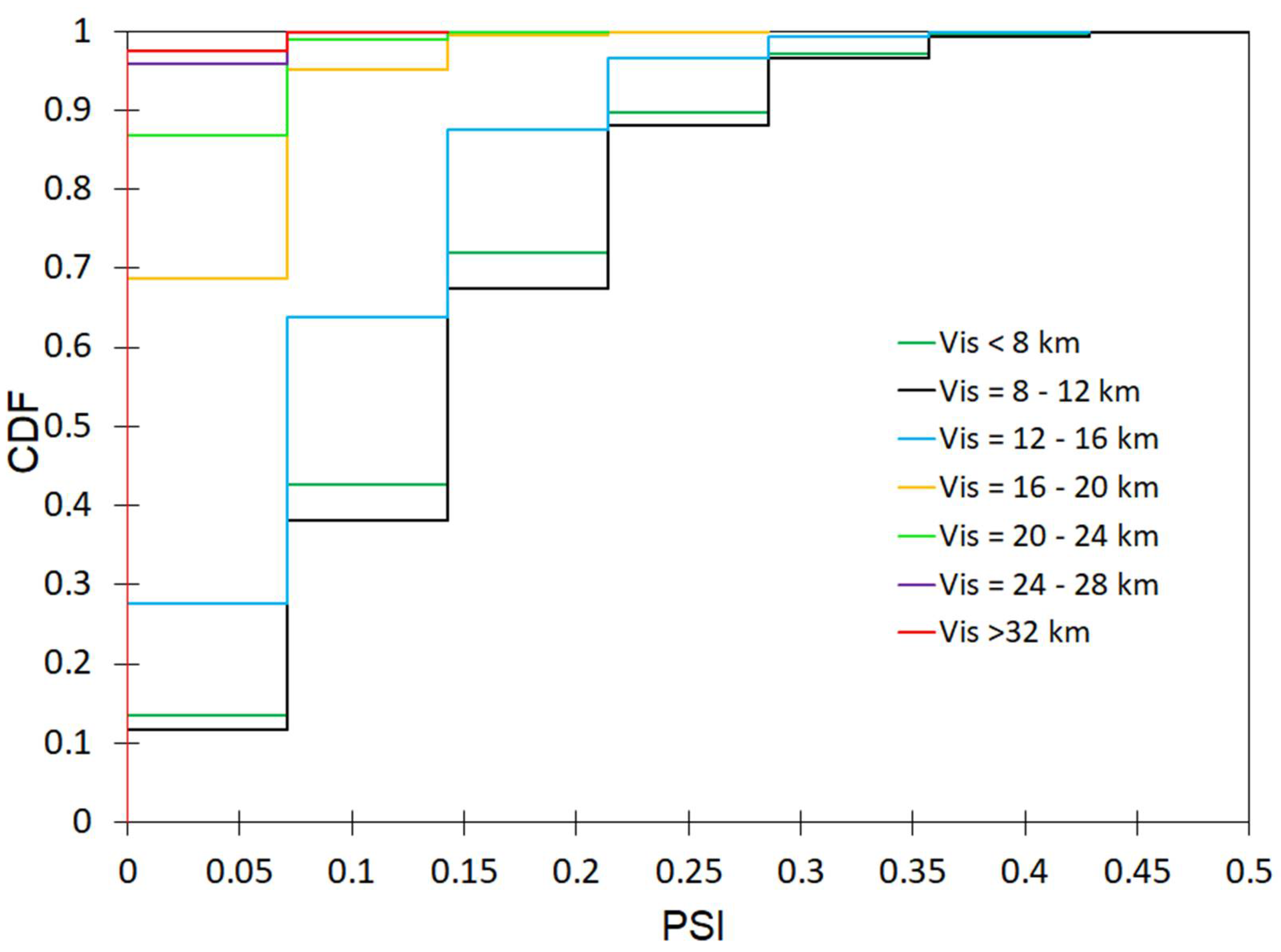
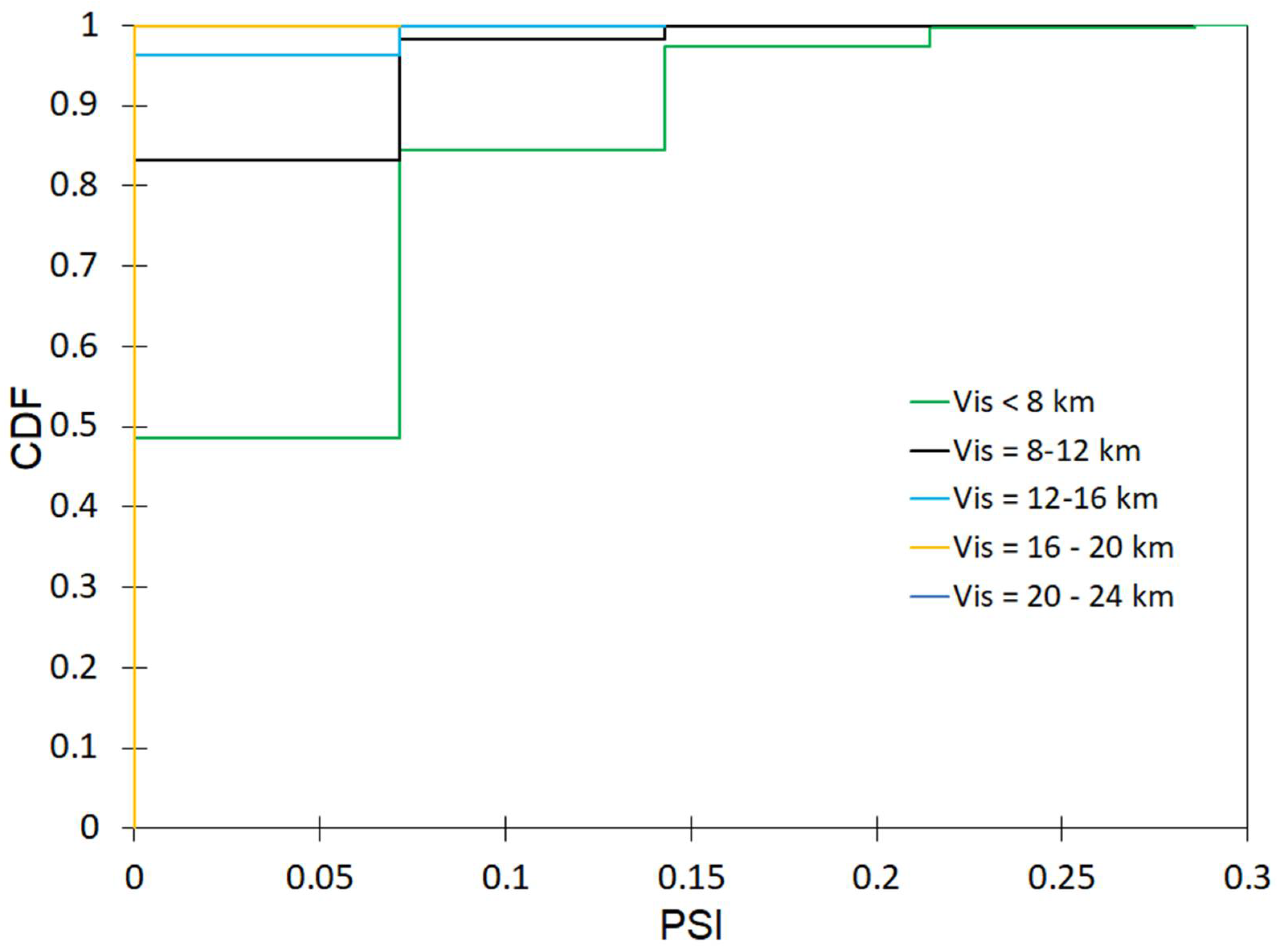

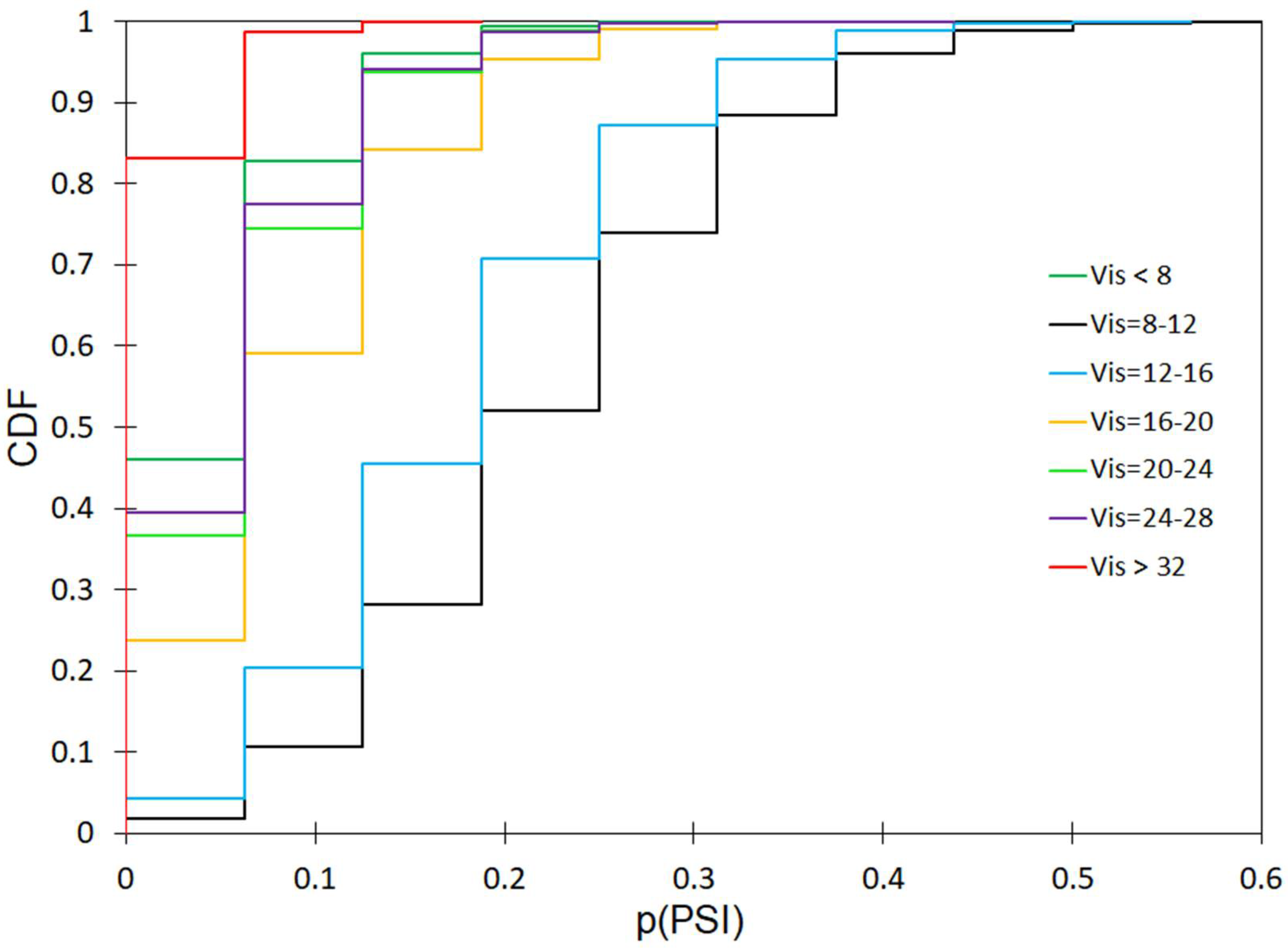



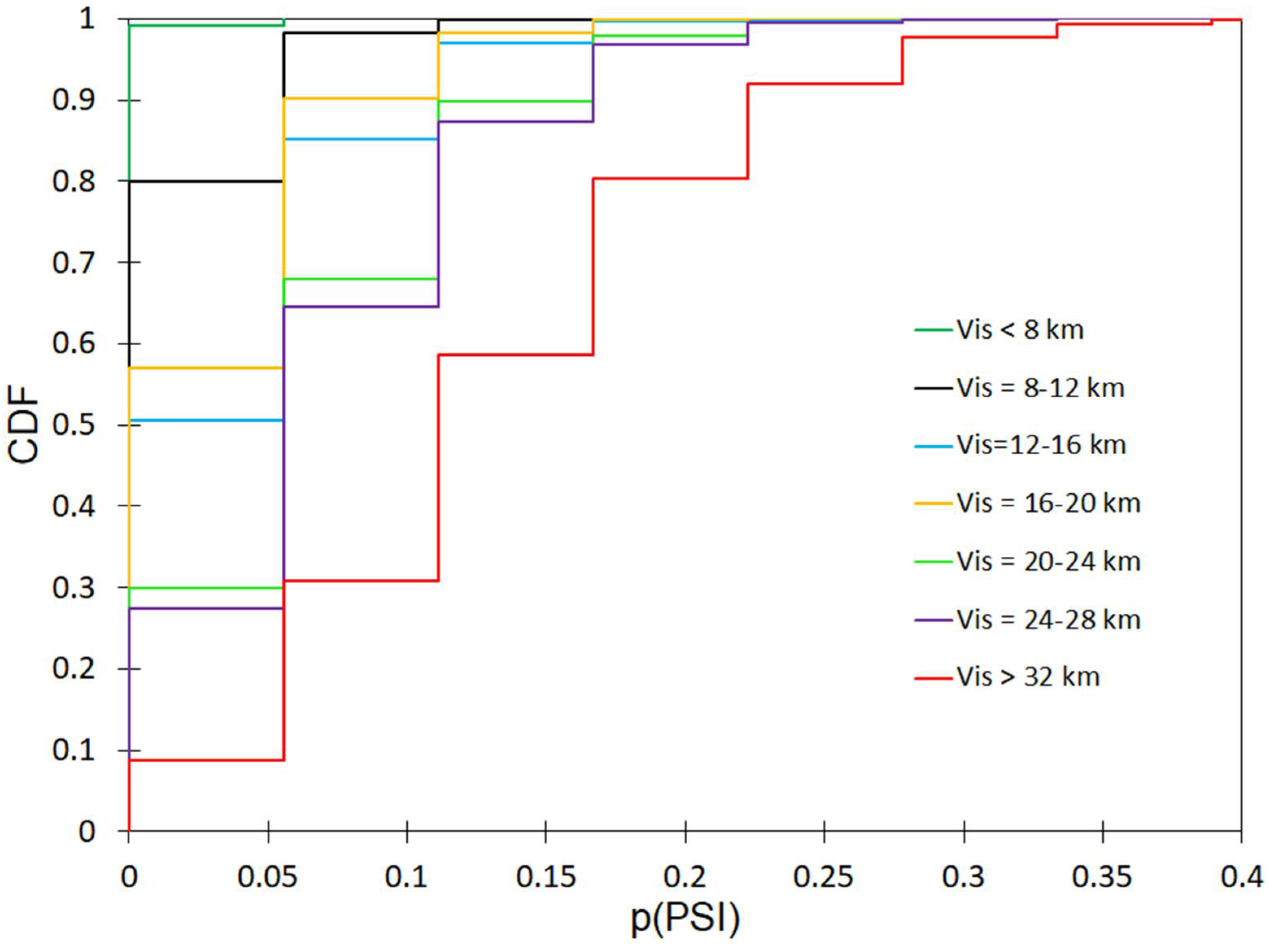

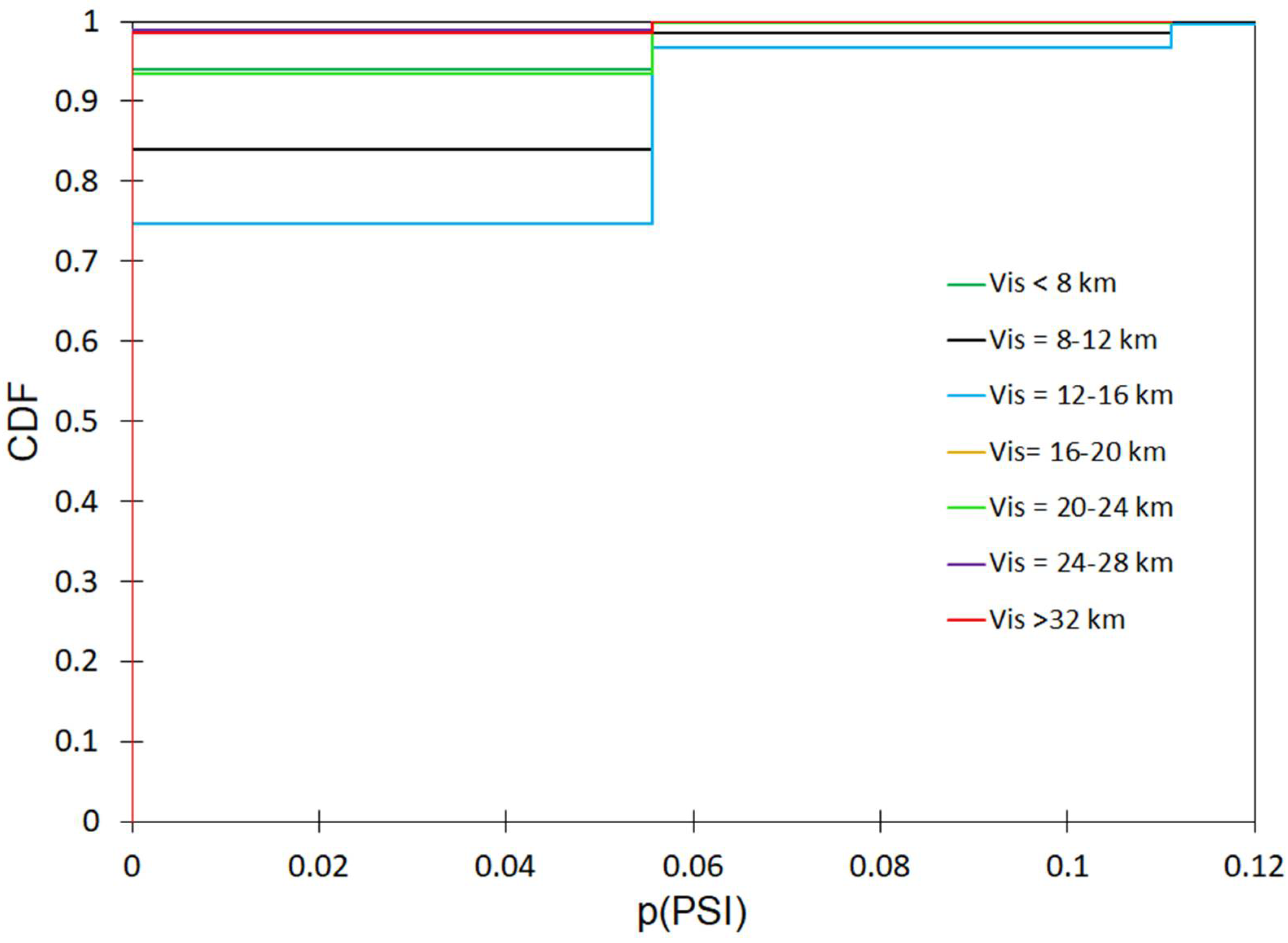

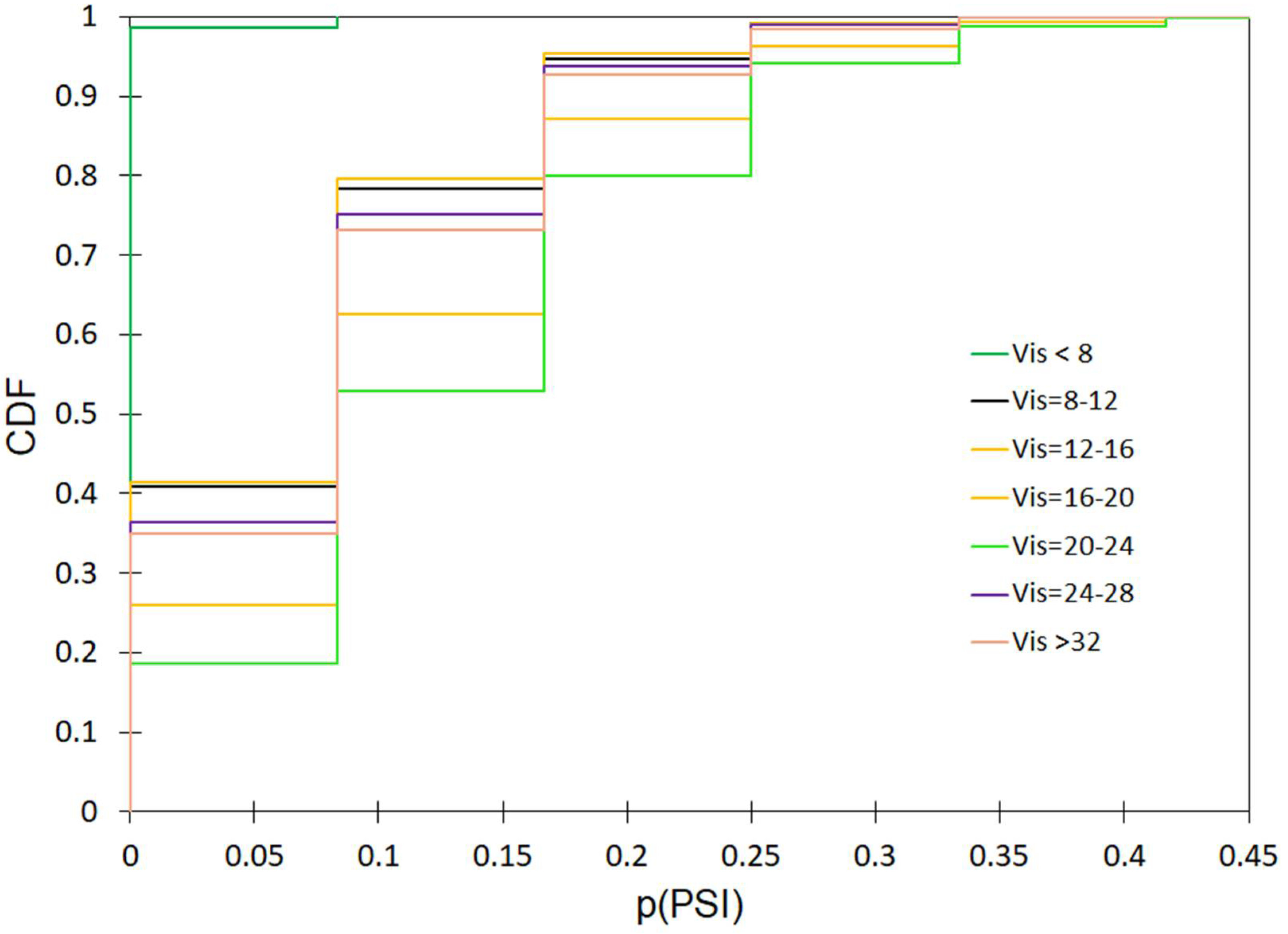

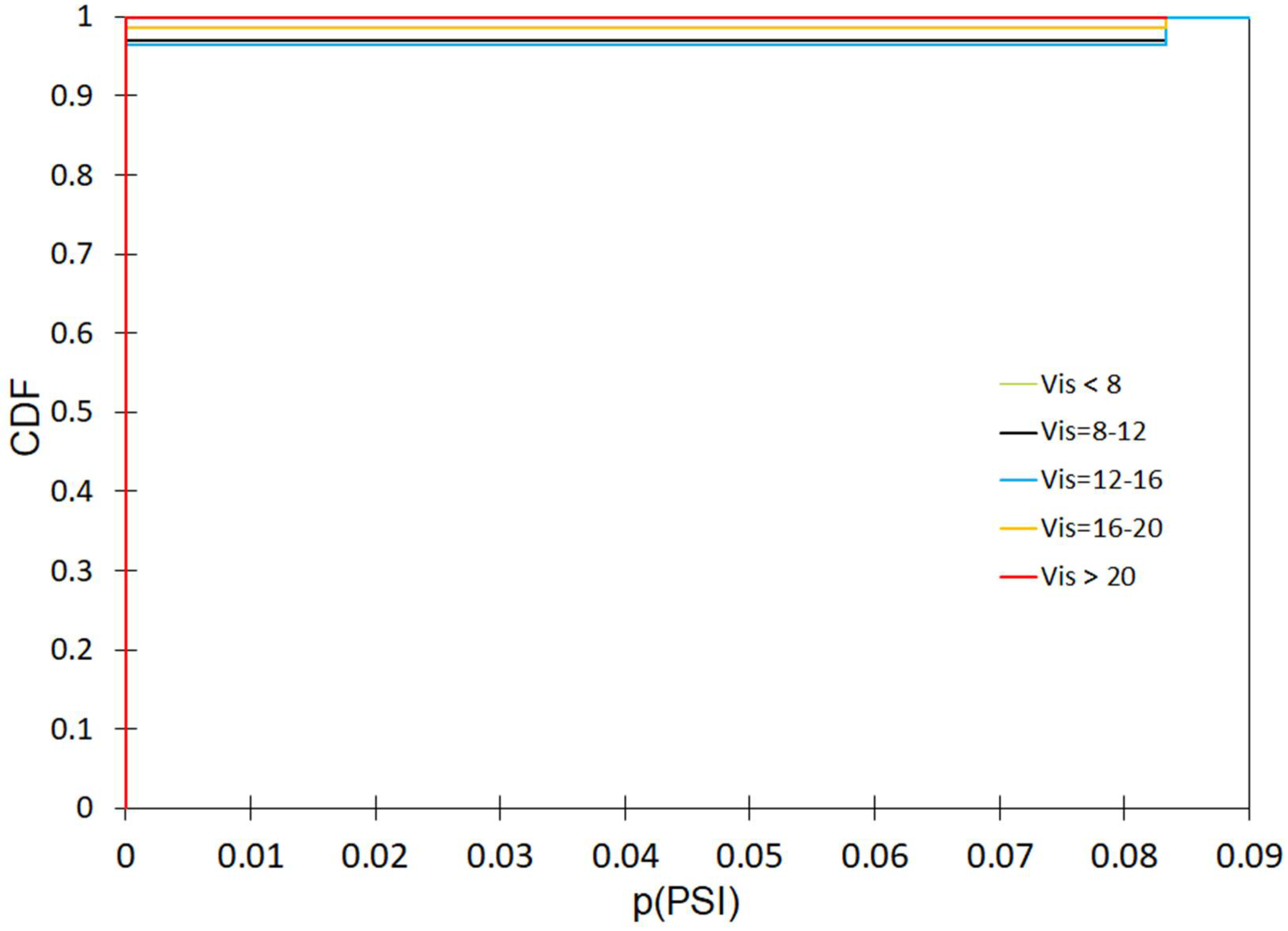
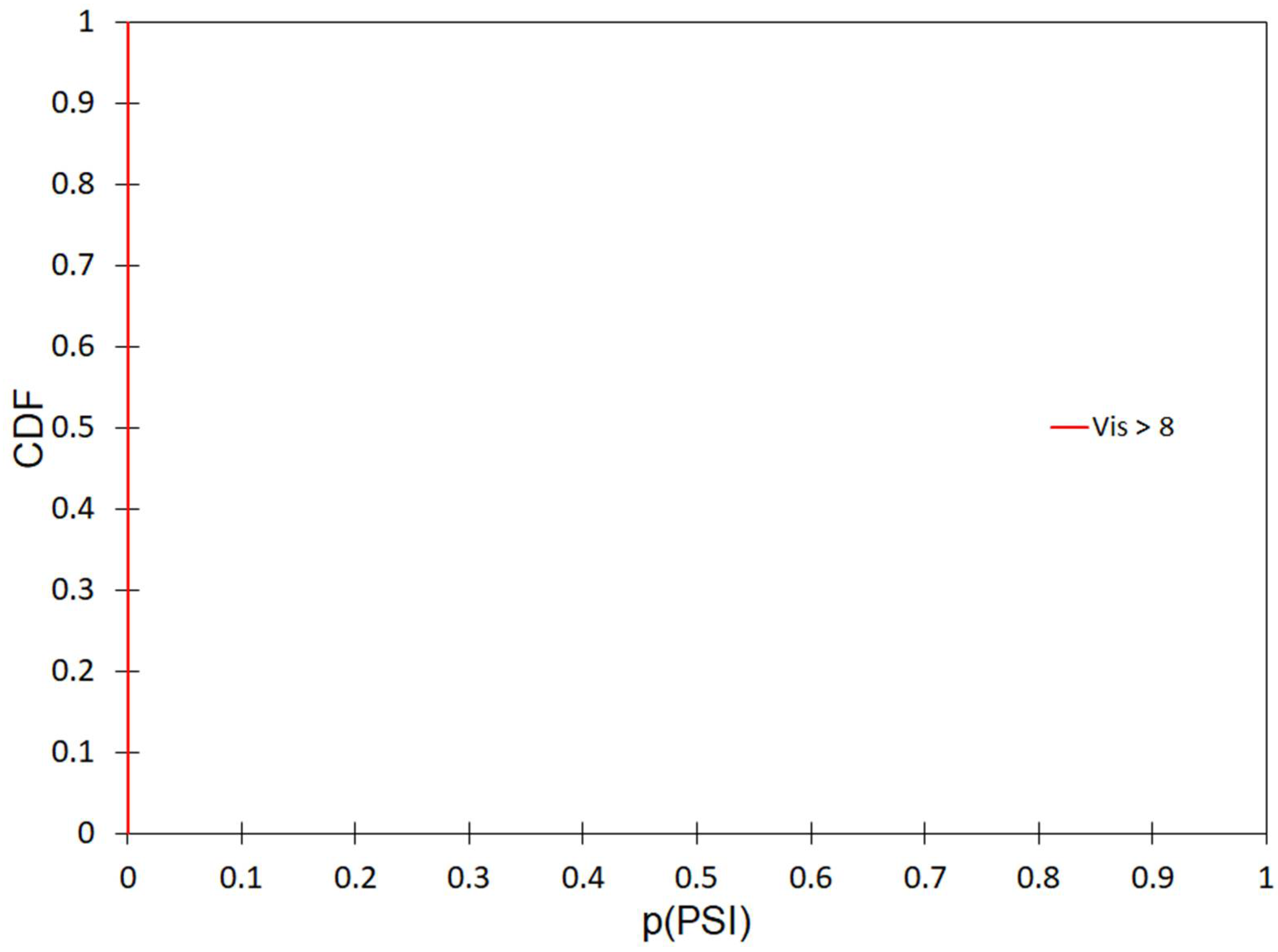
References
- World Health Organization (WHO). Ambient Air Pollution: Health Impacts; World Health Organization: Geneva, Switzerland, 2016; Available online: https://www.who.int/publications/i/item/9789241511353 (accessed on 10 November 2021).
- Kuo, C.-Y.; Cheng, F.-C.; Chang, S.-Y.; Lin, C.Y.; Chou, C.C.; Chou, C.-H.; Lin, Y.-R. Analysis of the major factors affecting the visibility degradation in two stations. J. Air Waste Manag. Assoc. 2013, 63, 433–441. [Google Scholar] [CrossRef] [PubMed]
- Thach, T.-Q.; Wong, C.-M.; Chan, K.-P.; Chau, Y.-K.; Chung, Y.-N.; Ou, C.-Q.; Yang, L.; Hedley, A.J. Daily visibility and mortality: Assessment of health benefits from improved visibility in Hong Kong. Environ. Res. 2010, 110, 617–623. [Google Scholar] [CrossRef] [PubMed]
- Liu, J.; Chen, E.; Zhang, Q.; Shi, P.; Gao, Y.; Chen, Y.; Liu, W.; Qin, Y.; Shen, Y.; Shi, C. The correlation between atmospheric visibility and influenza in Wuxi city, China. Medicine 2020, 99, e21469. [Google Scholar] [CrossRef] [PubMed]
- Han, L.; Sun, Z.; He, J.; Hao, Y.; Tang, Q.; Zhang, X.; Zheng, C.; Miao, S. Seasonal variation in health impacts associated with visibility in Beijing, China. Sci. Total Environ. 2020, 730, 139149. [Google Scholar] [CrossRef] [PubMed]
- Muhammad, S.; Long, X.; Salman, M. COVID-19 pandemic and environmental pollution: A blessing in disguise? Sci. Total Environ. 2020, 728, 138820. [Google Scholar] [CrossRef] [PubMed]
- Yao, L.; Kong, S.; Zheng, H.; Chen, N.; Zhu, B.; Xu, K.; Cao, W.; Zhang, Y.; Zheng, M.; Cheng, Y.; et al. Co-benefits of reducing PM2.5 and improving visibility by COVID-19 lockdown in Wuhan. npj Clim. Atmos. Sci. 2021, 4, 40. [Google Scholar] [CrossRef]
- Myllyvirta, L.; Thieriot, H. 11,000 Air Pollution-Related Deaths Avoided in Europe as Coal. Oil Consumption Plummet. 2020. Available online: https://energyandcleanair.org/wp/wp-content/uploads/2020/04/CREA-Europe-COVID-impacts.pdf (accessed on 10 November 2021).
- Sahu, S.K.; Mangaraj, P.; Beig, G.; Tyagi, B.; Tikle, S.; Vinoj, V. Establishing a link between fine particulate matter (PM2.5) zones and COVID-19 over India based on anthropogenic emission sources and air quality data. Urban Clim. 2021, 38, 100883. [Google Scholar] [CrossRef]
- Chung, Y.S.; Kim, H.S.; Yoon, M.B. Observations of Visibility and Chemical Compositions Related to Fog, Mist and Haze in South Korea. Water Air Soil Pollut. 1999, 111, 139–157. [Google Scholar] [CrossRef]
- Kim, S.; Lee, S.; Hwang, K.; An, K. Exploring Sustainable Street Tree Planting Patterns to Be Resistant against Fine Particles (PM2.5). Sustainability 2017, 9, 1709. [Google Scholar] [CrossRef]
- Zhao, Z.; Chen, S.-H.; Kleeman, M.J.; Tyree, M.; Cayan, D. The Impact of Climate Change on Air Quality–Related Meteorological Conditions in California. Part I: Present Time Simulation Analysis. J. Clim. 2011, 24, 3344–3361. [Google Scholar] [CrossRef][Green Version]
- Zhang, F.; Chen, J.; Qiu, T.; Yin, L.; Chen, X.; Yu, J. Pollution Characteristics of PM2.5 during a Typical Haze Episode in Xiamen, China. Atmos. Clim. Sci. 2013, 3, 427–439. [Google Scholar] [CrossRef]
- Deng, J.; Wang, T.; Jiang, Z.; Xie, M.; Zhang, R.; Huang, X.; Zhu, J. Characterization of visibility and its affecting factors over Nanjing, China. Atmos. Res. 2011, 101, 681–691. [Google Scholar] [CrossRef]
- Du, K.; Mu, C.; Deng, J.; Yuan, F. Study on atmospheric visibility variations and the impacts of meteorological parameters using high temporal resolution data: An application of Environmental Internet of Things in China. Int. J. Sustain. Dev. World Ecol. 2013, 20, 238–247. [Google Scholar] [CrossRef]
- Tsai, Y.I.; Kuo, S.-C.; Lee, W.-J.; Chen, C.-L.; Chen, P.-T. Long-term visibility trends in one highly urbanized, one highly industrialized, and two Rural areas of Taiwan. Sci. Total Environ. 2007, 382, 324–341. [Google Scholar] [CrossRef]
- Majewski, G.; Rogula-Kozłowska, W.; Czechowski, P.O.; Badyda, A.; Brandyk, A. The Impact of Selected Parameters on Visibility: First Results from a Long-Term Campaign in Warsaw, Poland. Atmosphere 2015, 6, 1154–1174. [Google Scholar] [CrossRef]
- Savapandit, M.R.R.; Gogoi, D.B. Bootstrap and Other Tests For Goodness of Fit. Sci. Math. Jpn. 2015, 78, 99–110. [Google Scholar] [CrossRef]
- Pyta, H. Classification of air quality based on factors of relative risk of mortality increase. Environ. Prot. Eng. 2008, 34, 111–117. [Google Scholar]
- Cairncross, E.K.; John, J.; Zunckel, M. A novel air pollution index based on the relative risk of daily mortality associated with short-term exposure to common air pollutants. Atmos. Environ. 2007, 41, 8442–8454. [Google Scholar] [CrossRef]
- World Health Organization (WHO). The World Health Report 2001—Mental Health: New Understanding, New Hope; World Health Organization: Geneva, Switzerland, 2001; Volume 79, p. 1085. [Google Scholar]
- Majewski, G.; Szeląg, B.; Mach, T.; Rogula-Kozłowska, W.; Anioł, E.; Bihałowicz, J.; Dmochowska, A.; Bihałowicz, J.S. Predicting the Number of Days with Visibility in a Specific Range in Warsaw (Poland) Based on Meteorological and Air Quality Data. Front. Environ. Sci. 2021, 9, 623094. [Google Scholar] [CrossRef]
- Rodriguez, M.Z.; Comin, C.H.; Casanova, D.; Bruno, O.M.; Amancio, D.R.; Costa, L.D.F.; Rodrigues, F. Clustering algorithms: A comparative approach. PLoS ONE 2019, 14, e0210236. [Google Scholar] [CrossRef]
- Kassambara, A. Multivariate Analysis I: Practical Guide to Cluster Analysis in R. Unsupervised Machine Learning; CreateSpace Independent Publishing Platform: Scotts Valley, CA, USA, 2017; p. 188. [Google Scholar]
- Jorquera, H.; Villalobos, A.M. Combining Cluster Analysis of Air Pollution and Meteorological Data with Receptor Model Results for Ambient PM2.5 and PM10. Int. J. Environ. Res. Public Health 2020, 17, 8455. [Google Scholar] [CrossRef] [PubMed]
- Saksena, S.; Joshi, V.; Patil, R.S. Cluster analysis of Delhi’s ambient air quality data. J. Environ. Monit. 2003, 5, 491–499. [Google Scholar] [CrossRef] [PubMed]
- Oleniacz, R.; Gorzelnik, T. Assessment of the Variability of Air Pollutant Concentrations at Industrial, Traffic and Urban Background Stations in Krakow (Poland) Using Statistical Methods. Sustainability 2021, 13, 5623. [Google Scholar] [CrossRef]
- Harrell, F.E. Regression Modeling Strategies: With Applications to Linear Models, Logistic Regression, and Survival Analysis; Springer: Berlin/Heidelberg, Germany, 2001; Available online: https://link.springer.com/book/10.1007/978-1-4757-3462-1 (accessed on 10 November 2021).
- Bagley, S.C.; White, H.; Golomb, B.A. Logistic regression in the medical literature:: Standards for use and reporting, with particular attention to one medical domain. J. Clin. Epidemiol. 2001, 54, 979–985. [Google Scholar] [CrossRef]
- Stojić, S.S.; Stanišić, S.; Stojić, A. Temperature-related mortality estimates after accounting for the cumulative effects of air pollution in an urban area. Environ. Health 2016, 15, 73. [Google Scholar] [CrossRef] [PubMed]
- Oguntunde, P.E.; Odetunmibi, O.A.; Adejumo, A.O. A Study of Probability Models in Monitoring Environmental Pollution in Nigeria. J. Probab. Stat. 2014, 2014, 864965. [Google Scholar] [CrossRef]
- Iman, R.L.; Conover, W.J. A distribution-free approach to inducing rank correlation among input variables. Commun. Stat.-Simul. Comput. 1982, 11, 311–334. [Google Scholar] [CrossRef]
- Singh, A.; George, J.P.; Iyengar, G.R. Prediction of fog/visibility over India using NWP Model. J. Earth Syst. Sci. 2018, 127, 26. [Google Scholar] [CrossRef]
- Lee, H.-H.; Iraqui, O.; Gu, Y.; Yim, S.H.-L.; Chulakadabba, A.; Tonks, A.Y.-M.; Yang, Z.; Wang, C. Impacts of air pollutants from fire and non-fire emissions on the regional air quality in Southeast Asia. Atmos. Chem. Phys. 2018, 18, 6141–6156. [Google Scholar] [CrossRef]
- Baklanov, A.; Zhang, Y. Advances in air quality modeling and forecasting. Glob. Transit. 2020, 2, 261–270. [Google Scholar] [CrossRef]
- So, R.; Teakles, A.; Baik, J.; Vingarzan, R.; Jones, K. Development of visibility forecasting modeling framework for the Lower Fraser Valley of British Columbia using Canada’s Regional Air Quality Deterministic Prediction System. J. Air Waste Manag. Assoc. 2018, 68, 446–462. [Google Scholar] [CrossRef] [PubMed]
- Pan, H.; Xue, J.; Huang, M.; Lei, X. Air Visibility Prediction Based on Multiple Models. In Proceedings of the 2018 IEEE 8th Annual International Conference on CYBER Technology in Automation, Control, and Intelligent Systems (CYBER), Tianjin, China, 19–23 July 2018; pp. 1421–1426. [Google Scholar] [CrossRef]
- Berger, V.W.; Zhou, Y. Kolmogorov–Smirnov Test: Overview; Wiley StatsRef: Statistics Reference Online; John Wiley & Sons: Hoboken, NJ, USA, 2014. [Google Scholar] [CrossRef]
- Irani, T.; Hamid, A.; Hedieh, D. Evaluating Visibility Range on Air Pollution using NARX Neural Network. J. Environ. Treat. Tech. 2020, 9, 540–547. [Google Scholar] [CrossRef]
- Huang, W.; Tan, J.; Kan, H.; Zhao, N.; Song, W.; Song, G.; Chen, G.; Jiang, L.; Jiang, C.; Chen, R.; et al. Visibility, air quality and daily mortality in Shanghai, China. Sci. Total Environ. 2009, 407, 3295–3300. [Google Scholar] [CrossRef] [PubMed]
- Shen, F.; Ge, X.; Hu, J.; Nie, D.; Tian, L.; Chen, M. Air pollution characteristics and health risks in Henan Province, China. Environ. Res. 2017, 156, 625–634. [Google Scholar] [CrossRef] [PubMed]
- R Core Team. R: A Language and Environment for Statistical Computing; R Foundation for Statistical Computing: Vienna, Austria, 2020; Available online: https://www.R-project.org/ (accessed on 5 July 2021).
- Murdoch, D.; Adler, D. rgl: 3D Visualization Using OpenGL. R Package Version 0.107.14. 2020. Available online: https://CRAN.R-project.org/package=rgl (accessed on 5 July 2021).

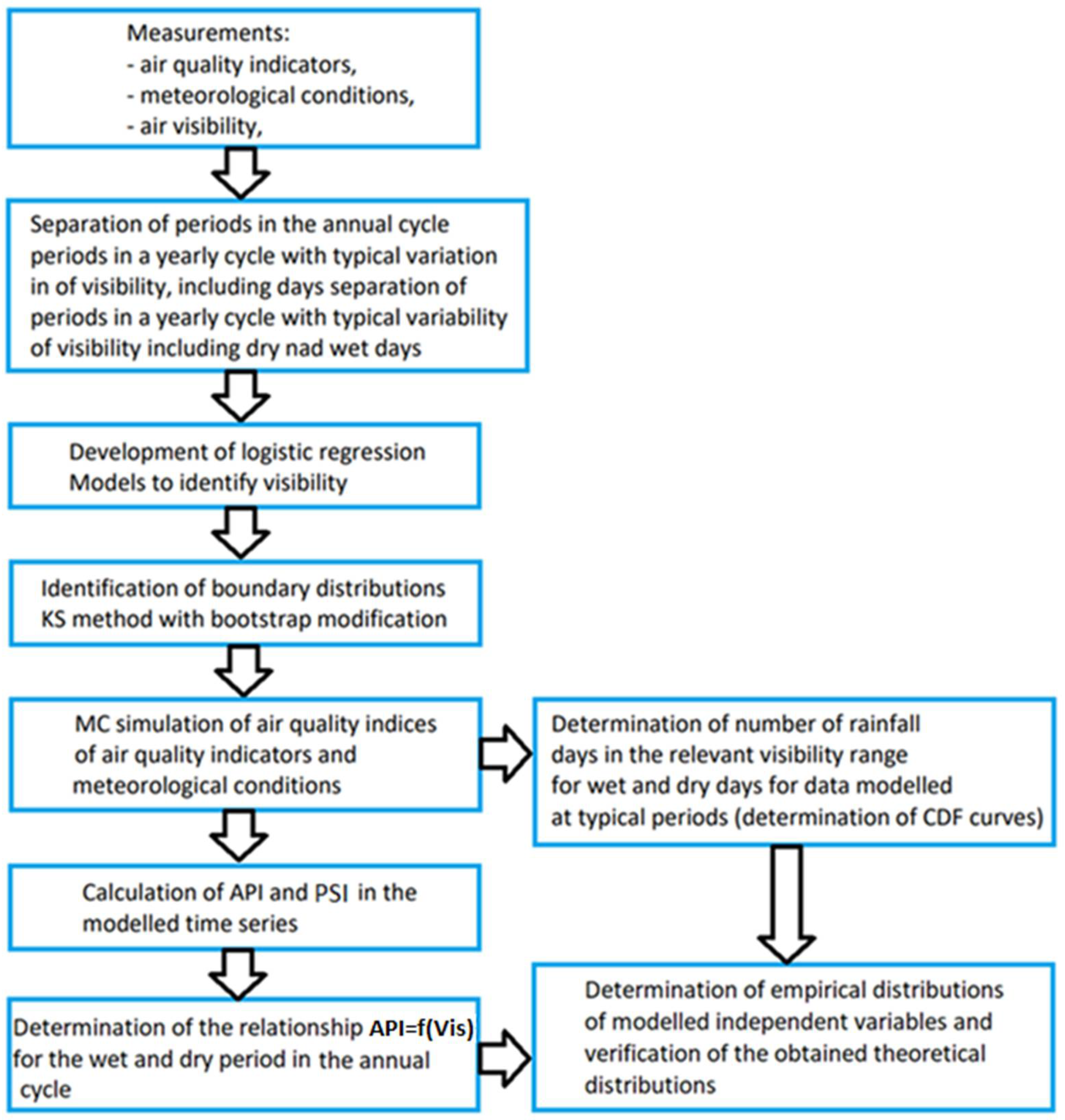




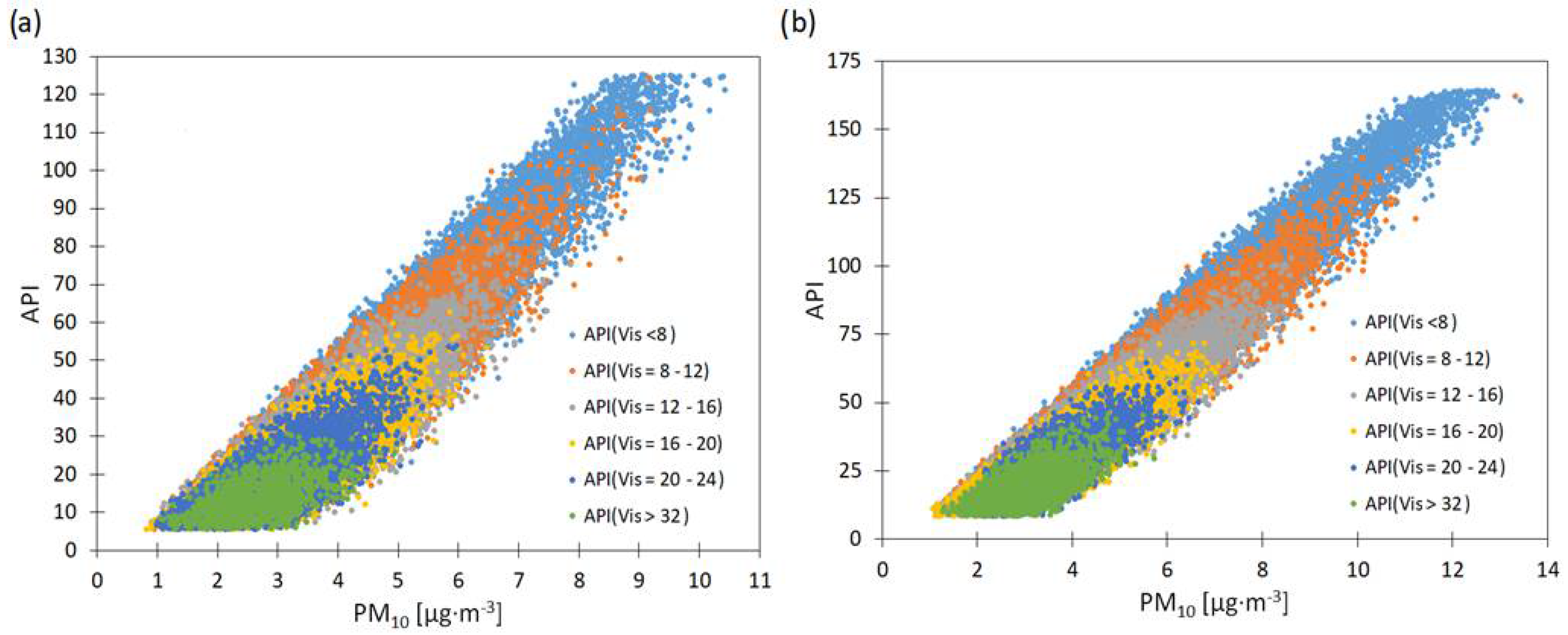

| Variables | Visibility [km] | ||||||
|---|---|---|---|---|---|---|---|
| 8 | 12 | 16 | 20 | 24 | 28 | 32 | |
| p | |||||||
| PM10 | 0.0011 | 0.0010 | 0.0034 | 0.0123 | 0.0078 | 0.0111 | 0.0126 |
| SO2 | 0.0160 | 0.0253 | 0.1360 | 0.0546 | 0.3450 | 0.4210 | 0.3560 |
| CO | 0.0210 | 0.0321 | 0.2670 | 0.0782 | 0.0128 | 0.1530 | 0.0236 |
| NO2 | 0.0300 | 0.0276 | 0.3190 | 0.1230 | 0.0245 | 0.0287 | 0.0219 |
| O3 | 0.2510 | 0.0317 | 0.4650 | 0.0342 | 0.0289 | 0.0353 | 0.0345 |
| T | 0.0016 | 0.0211 | 0.0120 | 0.0216 | 0.0110 | 0.0267 | 0.0129 |
| V | 0.0235 | 0.0541 | 0.0267 | 0.0432 | 0.2340 | 0.3460 | 0.0238 |
| Rh | 0.0124 | 0.0121 | 0.0231 | 0.0187 | 0.0120 | 0.0098 | 0.0111 |
| Pt | 0.0156 | 0.0349 | 0.0365 | 0.0401 | 0.0312 | 0.0278 | 0.0421 |
| Pe(z) | 0.0234 | 0.1230 | 0.0342 | 0.0423 | 0.0345 | 0.0327 | 0.2780 |
| Pe(l) | 0.0341 | 0.0980 | 0.0289 | 0.0383 | 0.0156 | 0.0278 | 0.3260 |
| DP | 0.2310 | 0.7890 | 0.5430 | 0.4890 | 0.4670 | 0.0345 | 0.0341 |
| SENS | 92.2 | 95.2 | 97.7 | 96.5 | 97.4 | 96.2 | 93.2 |
| SPEC | 93.3 | 96.4 | 94.2 | 94.3 | 95.3 | 94.1 | 91.8 |
| Accuracy | 93.0 | 96.0 | 96.5 | 95.7 | 96.3 | 95.6 | 92.7 |
Publisher’s Note: MDPI stays neutral with regard to jurisdictional claims in published maps and institutional affiliations. |
© 2021 by the authors. Licensee MDPI, Basel, Switzerland. This article is an open access article distributed under the terms and conditions of the Creative Commons Attribution (CC BY) license (https://creativecommons.org/licenses/by/4.0/).
Share and Cite
Majewski, G.; Szeląg, B.; Białek, A.; Stachura, M.; Wodecka, B.; Anioł, E.; Wdowiak, T.; Brandyk, A.; Rogula-Kozłowska, W.; Łagód, G. Relationship between Visibility, Air Pollution Index and Annual Mortality Rate in Association with the Occurrence of Rainfall—A Probabilistic Approach. Energies 2021, 14, 8397. https://doi.org/10.3390/en14248397
Majewski G, Szeląg B, Białek A, Stachura M, Wodecka B, Anioł E, Wdowiak T, Brandyk A, Rogula-Kozłowska W, Łagód G. Relationship between Visibility, Air Pollution Index and Annual Mortality Rate in Association with the Occurrence of Rainfall—A Probabilistic Approach. Energies. 2021; 14(24):8397. https://doi.org/10.3390/en14248397
Chicago/Turabian StyleMajewski, Grzegorz, Bartosz Szeląg, Anita Białek, Michał Stachura, Barbara Wodecka, Ewa Anioł, Tomasz Wdowiak, Andrzej Brandyk, Wioletta Rogula-Kozłowska, and Grzegorz Łagód. 2021. "Relationship between Visibility, Air Pollution Index and Annual Mortality Rate in Association with the Occurrence of Rainfall—A Probabilistic Approach" Energies 14, no. 24: 8397. https://doi.org/10.3390/en14248397
APA StyleMajewski, G., Szeląg, B., Białek, A., Stachura, M., Wodecka, B., Anioł, E., Wdowiak, T., Brandyk, A., Rogula-Kozłowska, W., & Łagód, G. (2021). Relationship between Visibility, Air Pollution Index and Annual Mortality Rate in Association with the Occurrence of Rainfall—A Probabilistic Approach. Energies, 14(24), 8397. https://doi.org/10.3390/en14248397








